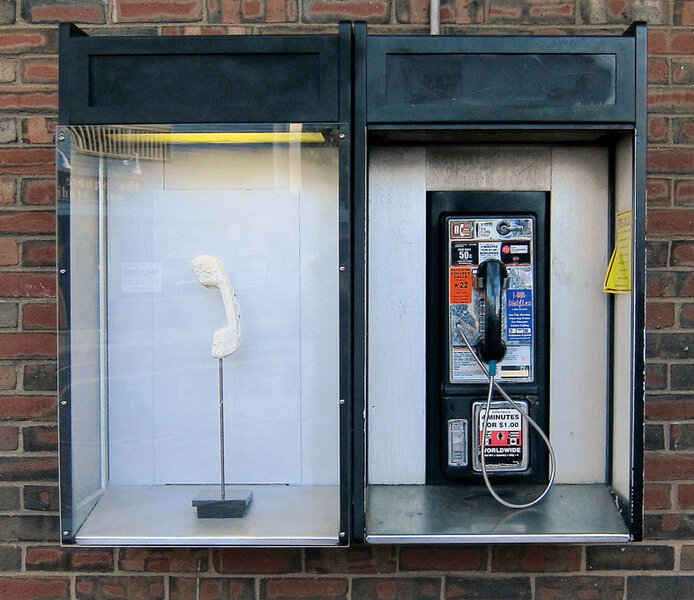A surprise hidden in a phone box
Loading...
Under a rainy ledge outside a Boston-area subway station, four people take shelter on a bench, absorbed in their smart phones. A woman in a fox-eared hat thumbs her phone’s display, and a man’s glasses reflect a Facebook page. A girl types using touch-screen gloves, and a woman listens to her phone, which is tucked under an earmuff.
Next to them, a pair of pay phone boxes sit quietly. On this rainy afternoon, nobody so much as glances at them. But if they did, they might notice something peculiar. Inside one of the boxes, an object shaped like a phone receiver but as white and porous as an ancient bone is impaled behind glass like an archaeological specimen.
Gary Duehr’s installation, called “Phone Fossil,” is one of five commissioned by the city of Somerville, Mass., to transform defunct pay phone boxes. Conceived by the city’s mayor, the Phone Art Box Project has allowed artists to bring delicate dioramas to the street art scene.
“People really like the fact that it’s unexpected,” says Susan Berstler, director of the Nave Gallery, which brought artists into the project. “I think that’s one of the beautiful things about public art: that people stumble across art that they’re not expecting to be there.”
Surprise is a powerful tool for many street artists, such as the popular and anonymous British graffiti artist Banksy, who wrapped up a month-long “residency” in New York City just a few days after the Somerville project’s roaming outdoor opening on Oct. 27.
Banksy is best known for using stencils and black spray paint to create images – often featuring children, flowers, and balloons – that play whimsically off existing features of the urban landscape to critique what he sees as state and corporate oppression.
The techniques and materials Banksy uses are often the same as the subjects he comments on: graffiti, illegal expression, private and public spaces. In a piece that recently appeared in New York, a robot spray-paints a bar code onto a wall, provoking questions about the relationship between free thought and free speech.
Somerville’s artists have taken a similar approach to their medium: They are using the shell of a vanishing cultural object to explore change and impermanence.
Mr. Duehr cast his plaster “fossil” in what might be the most ephemeral of mediums: sand. He checks on the piece periodically, but knows it won’t be there forever.
“Give me a run of a year or two,” he says. “But then, let time take its toll.”








